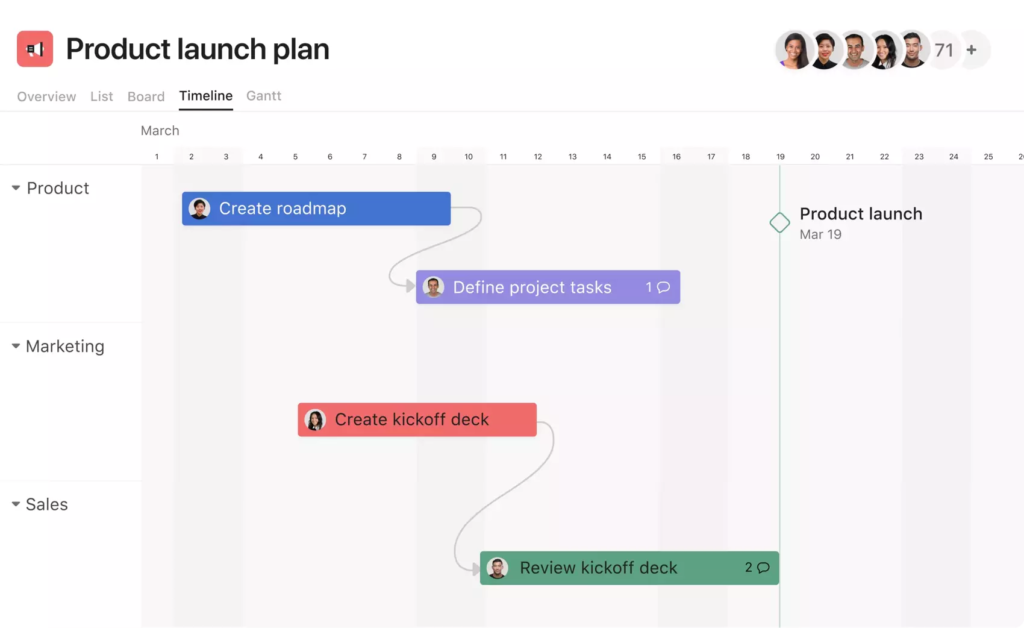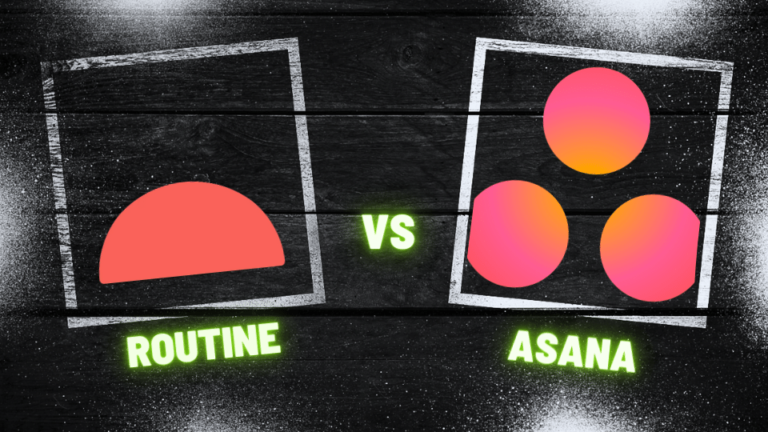What is Asana
Asana stands out as a versatile project management tool, ideal for various team sizes. Its user-friendly interface, coupled with diverse features like task management, project visualization (including Kanban and Gantt charts), and robust team collaboration tools, makes it a top choice. Additionally, Asana’s integration capabilities with other apps enhance workflow efficiency. Offering a range of pricing plans, including a free version for smaller teams, Asana caters to a broad spectrum of organizational needs. It’s particularly recommended for its ease of use, extensive integrations, and comprehensive project management features.

Key Features of Asana
- Task Management: Asana excels in task management, allowing users to create, assign, and track tasks efficiently. This feature ensures that team members are always aware of their responsibilities and deadlines, promoting productivity and accountability.
- Project Visualization: With options like Kanban boards and Gantt charts, Asana offers versatile visualization tools. These features aid in understanding the project flow and milestones, making it easier to manage timelines and resources.
- Team Collaboration: Asana fosters seamless team collaboration. It allows for easy communication within tasks, sharing of files, and updating progress, thus keeping everyone on the same page and enhancing teamwork.
- Integration Capabilities: The platform integrates with a wide range of other applications and tools, streamlining workflows and automating processes. This integration makes it a flexible tool that can adapt to various business ecosystems.
- Customization and Reporting: Asana offers extensive customization options, including custom fields and reporting features. These allow teams to tailor their project management experience and generate insightful reports for better decision-making.
- User-Friendly Interface: The intuitive interface of Asana is designed for ease of use, making it accessible for teams regardless of their technical expertise. This simplicity ensures a smooth onboarding process and enhances overall user experience.
What is Routine
Routine is a productivity tool that sets itself apart with its all-in-one approach, combining elements of task management, note-taking, and calendar integration into a single platform. Designed to cater to the needs of busy professionals and individuals seeking to streamline their organizational process, Routine offers a comprehensive solution for managing daily tasks, appointments, and notes. Its unique selling point is the integration of these features within an intuitive and user-friendly interface, making it easier for users to track their to-dos, schedule their days, and store important information in one place. This level of integration is particularly useful for those who prefer a unified system to manage various aspects of their work and personal life.

Key Features of Routine
- Timeline Agenda: Offers a detailed view of the day’s plan with timestamps, including meeting and event reminders, with options to time-block tasks.
- Week Calendar: Provides a 5-day, week, and month view for task planning, integrating seamlessly with Google Calendar.
- Console Capture: A desktop feature for capturing events, notes, and tasks outside the application, ideal for GTD enthusiasts.
- Centralized Workspace: Combines tasks, notes, and calendar in one space.
- Organization: Utilizes categories and tags for better event and task management.
- Daily Plan: Helps in crafting focused daily tasks and important events.
Asana vs Routine: Features
| Features | Asana | Routine |
|---|---|---|
| Integrations | Google Drive, Slack, Zoho Cliq, Zapier, Jira, Zoom, Toggl Track, Loom, Harvest, Gmail | Syncs with multiple calendar services and task managers like Todoist and Google Tasks. |
| Calendar | Yes | Google Calendar, Notion, Slack, Zapier, Siri, Gmail |
| Platforms | macOS, iOS, Android, Web, and Windows | macOS, Windows, iOS, Android, Web |
| Task Management | Task creation and assignment, due date setting, progress tracking, project organization, tagging, comments, file attachments, task conversations | No |
| Natural Language Processing | Yes | Offers task creation with date assignment via drag-and-drop |
| Time Blocking | No | Available |
| Analytics | Yes | No |
| Meeting Scheduler | No | No |
| Time Zones | Yes | Yes |
| Reminders | Yes | Yes |
| Customer Support | Average | Average |
| 1:1 User Onboarding | Asana offers customer success services including tailored training and consultation, which might include onboarding calls for new users, especially in enterprise plans | No |
| Pricing | Asana offers three plans: the free Personal plan for basic needs, the Starter plan at $11.59 for expanded features like timeline view, and the Advanced plan at $25.69 for comprehensive project management tools including time tracking and advanced customization. | $12 per month, annually |
Asana vs Routine: Pricing
Asana Pricing
Asana offers three main pricing tiers:
(i) Personal: This is a free plan, suitable for small teams or individuals. It includes basic project and task management features and supports collaboration with up to 10 team members. Users have access to unlimited tasks, projects, messages, and file storage.
(ii) Starter: Priced at $11.59 per user per month, this plan builds on the Personal plan. It allows collaboration with up to 500 teammates and introduces additional features like timeline and Gantt chart views, along with the ability to use forms and automation.
(iii) Advanced: At $25.69 per user per month, the Advanced plan includes all features from the lower tiers and adds functionalities such as goals, time tracking, proofing, approvals, and more advanced customization options.
Each tier offers a range of features to accommodate different needs, from individual use to more complex team collaboration and project management requirements.
Routine Pricing
(i) Free Version: Available for students and hobbyists, though with limited features.
(ii) Professional Plan: Priced at $12 per month.
(iii) Business Plan: Costs $15 per user per month.
(iv) Believer Plan: Priced at $10 monthly or $8 per month for an annual commitment, totaling around $96 annually
Asana vs Routine: Reviews
Asana Review
Asana, a popular project management tool, is praised for its intuitive interface and robust feature set, making it an excellent choice for teams of all sizes. Key strengths include versatile project views, effective task and assignment management, and smooth team collaboration. Users benefit from a variety of project views like Kanban Board, Timeline, and Gantt, alongside templates for quick project setup. Asana’s progress tracking and integration with various tools like Google Suite and Microsoft 365 further enhance its utility. However, the tool’s complexity might be overwhelming for beginners, and the cost of the Advanced package may be a concern for smaller teams or individual users.
Routine Review
Routine stands out for its exceptional design, skillfully combining elements of daily planning, note-taking, and journaling into a user-friendly interface. The application’s free version is especially popular among students and individuals using it for personal or hobbyist projects, making it a preferred choice in these communities. Additionally, Routine’s smart planning and scheduling capabilities are highly valued by users who favor an automated, intelligent approach to organizing their tasks and appointments. However, a significant limitation of Routine, particularly in its free version, is the constrained number of integrations it offers. This restriction is frequently mentioned by users as a downside, as it may limit the app’s effectiveness in more integrated digital workflows.
Which One Should You Pick
Consider Asana if
- You’re Managing Diverse Projects: Asana is suitable for various project types, offering flexibility with multiple view options like Kanban and Gantt charts. However, it might take time to master all the features.
- You Value Integration: Asana’s integration with many tools (like Google Suite, Microsoft 365) enhances its utility. But, be mindful that depending on external apps could complicate workflows.
- You Prioritize Team Collaboration: Asana is strong in team collaboration features, making it easy to track responsibilities and updates. Still, for very small teams or individual use, the platform might offer more than needed.
Consider Routine if
- You Want a Balance Between Calendar and Task Management: Routine offers a mix of these features, but it might not be as comprehensive as some specialized apps in either category.
- You Like Quick Task and Note Capturing: The app has convenient features for this, though it’s not a full-fledged note-taking application
- You’re Looking for a Personal Planner: Routine is more suited to personal use and less technical users, but it might not meet all the needs of power users or large teams.
Best Asana and Routine Alternatives
- Akiflow: Akiflow is a time management app offering time blocking, task scheduling, and integrations with various tools. It focuses on productivity and organization through a unified task and appointment interface.
Akiflow Price: $19 per month, paid annually - Todoist: Todoist is a task management tool. It enables users to manage tasks, set priorities, and track deadlines across various devices. Its features include task categorization, reminders, and project collaboration, making it suitable for both personal and team productivity.
Todoist Price: Premium at $4 per month, paid annually - Trello: Trello is a visual collaboration tool for planning tasks and projects. With an intuitive interface of boards, lists, and cards, it helps teams organize work and manage projects effectively.
Trello Price: Free Plan for individuals and small teams, Standard Plan at $5 per user/month (billed annually), Premium Plan at $10 per user/month (billed annually), and an Enterprise Plan for larger organizations at $17.50 per user/month (billed annually)

Best Time Blocking Web and Desktop Apps, 2024
Explore the best time blocking apps of 2024! Discover how Akiflow, TickTick, Usemotion, Sunsama, Sortedapp, and TimeHero revolutionize productivity, offering unique features for professionals and students to manage tasks and enhance efficiency.

Improve Focus: 5 ADHD Productivity Tools & Calendar Apps for 2023
Discover five of the best apps and tools for those with ADHD, from note-taking apps to time-blocking platforms. Get ready to stay organised, motivated and on track with Akiflow’s essential guide.

The Top 3 Todoist Alternatives (In-Depth Review)
Over 25 million people now use Todoist to stay on track and plan their day. It has expanded rapidly and is now a widely used task manager with seamless integrations into other task and calendar managers like Akiflow. While Todoist is hugely popular among its wide user base, there are now a variety of Todoist […]

